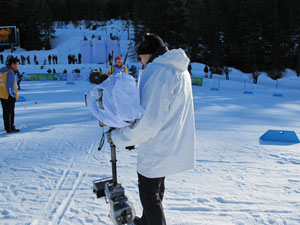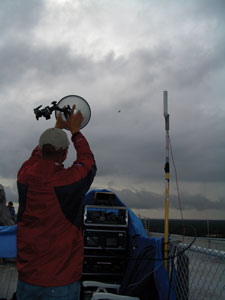The show must go on
In a business where most of its work is done outdoors, it’s no surprise that weather plays a huge role in how Broadcast Sports Inc. (BSI) prepares for events week to week. The company provides wireless audio, video and communications technology and support for live broadcasts of golf, racing, marathons, parades, sailing, surfing and skiing competitions, and a variety of other sport and entertainment events. Many shows involve setting up equipment in exposed areas, running thousands of feet of fiber-optic cable over varying types of terrain and deploying cameras and microphones to the far reaches of a particular location.
Extreme weather
Certain environments regularly present challenging conditions that BSI has become adept at handling. For many years, the company has provided wireless technology to ESPN for the Winter X Games. As an event that takes place primarily on the side of a mountain, it’s one where deploying wireless equipment is extremely beneficial. It’s also one where our team of technicians must take special precautions to ensure that the equipment is still fully functional even in below-freezing temperatures. One of the simplest things the team does is to store and prepare all of the camera equipment in temperatures at or near the external temperature. This prevents condensation from building up and freezing on the camera lenses which occurs when constantly moving between warm and cold environments.

To prevent condensation from freezing on camera lenses, BSI teams store their camera gear at or near the external temperature.
Although we monitor and prepare for forecasted weather conditions prior to arriving at a venue, there’s always a chance that unexpected weather events may arise. The most notable example recently was the “derecho” that hit last year’s AT&T National golf tournament at Congressional Country Club in Bethesda, MD. Although the forecast accurately predicted the approaching storm, the region was completely unprepared for its magnitude. With winds reaching 80mph, heavy rain and intense lightning, the storm left millions in the area without power. Downed trees and debris covered the course and surrounding roads, leaving tournament organizers to delay play and prohibit spectators from entering the course.
Despite the severity of the storm, the field team arrived at the course and, as expected, found all of its equipment in place and fully functioning, ready for the day’s broadcast. They credited their careful worst-case scenario preparations and a little bit of good luck for the outcome. When the network broadcasts went live, our technology and RF infrastructure allowed the camera operators to travel freely around the course without being inhibited by the obstacles that resulted from the storm.
“Our teams take great pains to ensure that every show goes smoothly,” said Peter Larsson, General Manager, BSI. “We can’t control what Mother Nature will send our way, but we have strict quality control standards in place that mitigate the effects of an incident like this. After 30 years in the business, we’ve seen our share of weather-related issues so we are always prepared for the worst.”
Equipment design
When the broadcast environment presents challenges, such as exposure to water or debris, that can’t be addressed with simple precautions, the company takes preparation to the next level by designing equipment that can withstand or neutralize these hazards.
When the company was tasked with designing cameras for the sailing events at the 2012 Olympic Games in London, not only did the cameras need to have a wide range of remote functionality, they needed to be completely waterproof as well. The resulting device, known as the PTRZ or Pan-Tilt-Roll-Zoom Camera, is capable of capturing 1080i video and enables complete wireless remote control of the pan, tilt, roll and zoom functionality as well as iris, focus, shutter speed, saturation and a number of other options. It’s sealed waterproof housing protects the battery, transmitter and internal moving parts from being damaged by sea spray and potential submersion.

Although BSI monitors and prepares for forecasted conditions, there’s always a chance for the unexpected.
We have also designed onboard cameras for auto racing that mitigate the effect that both weather conditions and general track conditions have on camera operation. Onboard cameras mounted on the exterior of a car are subject not only to rain, but also to asphalt, hot rubber tire particles and a variety of engine fluids from other cars. Without the ability to clean the lenses throughout the race, these cameras would become useless as races go on due to lack of visibility and clarity of the images they produce.
We addressed this problem with its tape clear camera system. The tape clear camera system incorporates a scrolling cellophane layer over the camera lens of certain onboard cameras. As the cellophane becomes wet or covered in debris, it can be scrolled to place a new, clear section of the tape over the lens. With a fresh roll of cellophane tape installed before each race, the tape can be cleared numerous times during the broadcast. This feature is controlled remotely from the production trailer as the team monitors the quality of each camera in operation during a race and makes adjustments to ensure impeccable video is produced for the broadcast.
The old standby
Although BSI works hard to prepare for weather conditions and incorporate advanced solutions into its technology, industry veterans know that in some ways, protecting equipment from the elements has not changed that much in the last 30 years. When a storm approaches and rain begins to fall, you’ll still see our crew covering thousands of dollars worth of equipment not with specially designed waterproof covers, but with good old-fashioned trash bags.
“In some ways, it’s the advancements in trash bag technology that have done the most to improve the protection of equipment in the elements,” Larsson jokes. “Despite how fast BSI’s technology is changing the way television is produced and viewed, there are times when we just have to follow the K-I-S-S principal and keep things simple. Sometimes a trash bag does the job just as well or better than anything else will.”
—Colleen Stanley is a sales and marketing specialist with Broadcast Sports Inc.
Get the TV Tech Newsletter
The professional video industry's #1 source for news, trends and product and tech information. Sign up below.
